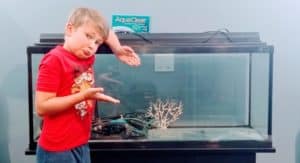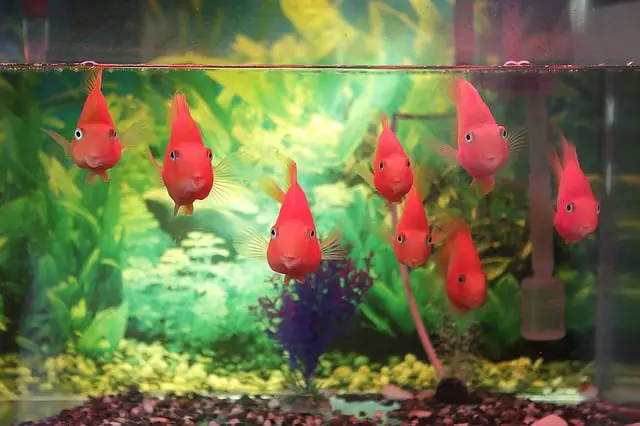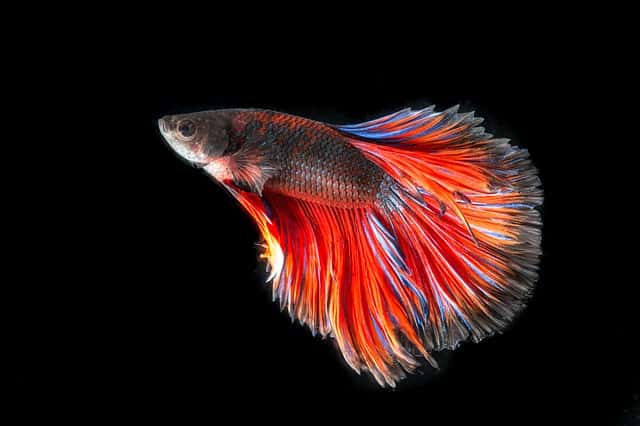Anyone who has ever had a freshwater fish tank for any length of time, has no doubt thought about starting up a saltwater fish tank. The aquarium hobby is very addictive and there are so many fish varieties available thanks to breeders as well as having the ability to purchase fish online.
Freshwater fish tanks can be converted to saltwater. A thorough cleaning of the freshwater fish tank after it is emptied should be performed. Gravel from a freshwater tank can be used in a saltwater tank but you should consider switching it out for coral sand or another substrate made specifically for saltwater tanks.
Most hobbyists will just start adding new tanks to their collection, however, that’s not always the right option for everyone. It obviously costs money to run the tanks as well they can start taking up a lot of space. This is such an addictive hobby that some fish tank owners have fish rooms filled with tanks. For the sake of this article, let’s just assume you have a freshwater tank and want to convert it to saltwater – regardless of the reason.
Of course, there are other considerations for switching tanks from freshwater to saltwater and that is what the rest of this article will cover. For the most part, making this switch isn’t that difficult and can be done fairly quickly. I do have a few excellent tips for you below that will help you make this decision or carry forward with the process.
Why its Possible to Switch a Freshwater Tank to Saltwater
It’s very obvious (yet you might not realize it) that if you have a freshwater tank, you have just about everything you need to get your saltwater tank running.
Let’s make a list of what you probably have and what you will need to run a basic fish only marine tank.
- An aquarium is hopefully the most obvious.
- A filtration system is required, and you most likely used one for your freshwater tank.
- Lighting is required and chances are you have that as well.
- A heater will be needed. I expect you have one of those as well.
The only other thing you probably have, but should replace, is the substrate. Aquarium gravel can work with a basic marine tank however using something such as coral sand will help buffer the water enabling you to get the water parameters you need much more easily than if you used gravel.
Coral sand is a more natural substrate than gravel as well and most of your fish will feel more at home if you provide it for them.

How to Clean and Prepare a Freshwater Tank for Saltwater?
It would be great if you could purchase some aquarium salt mix and just mix it into your freshwater tank and be done with it but it’s not quite that simple or easy. Sure, you can switch your freshwater tank to saltwater, but you will need to start from scratch.
- The freshwater tank will need to be emptied of its water and the substrate taken out to be replaced by a substrate such as coral sand, as previously explained.
- I would recommend replacing all filter mediums, and here’s why. Even though the freshwater filters sponge might have beneficial bacteria, there are two problems to consider. 1 – the bacteria will die off when you fill the tank with new RO water for your saltwater tank. 2 – there could be toxins present in the filter. These toxins might have built up just from being in an older tank or maybe you had to medicate the aquarium and there are still remnants in the filter. Just to be safe, use a clean new sponge and charcoal in your filter.
- Take out any plastic decorations unless they’re saltwater safe. Live rock, dead coral and fake live rock make much nicer decorations for a marine tank.
- The inside of the tank will need to be wiped down with vinegar and water as well the inside of the filter. Feel free to wipe off the heater and anything else that protrudes into the water such as a filter inlet.
- Once you have everything wiped down or thrown out, you can start putting the tank back together. Before you put the coral sand in the tank, make sure to rinse it in a bucket or sink until the cloudiness dissipates. Put the sand in and then place any rocks or coral in the tank.
- Now you can place the heater filter on the tank. Set the temperature to 75 or 76 Fahrenheit (23 to 24 Celcius). You could go up to about 78 degrees Fahrenheit if you want. I like to keep the temperature a couple of degrees lower as I find outside conditions such as a furnace running sometimes boosts the tanks temp slightly especially in the winter months here in Canada.
- Last, but not least, the new saltwater needs to be added. Using Reverse Osmosis water and an aquarium salt mix from your local fish store or Amazon like this instant ocean aquarium salt. Mix according to the directions on the package. You’ll need to get the water to a specific salinity and gravity. The best way to know if your water is where it should be is to purchase a salinity tester (hydrometer) like this one.
- For your information, the proper salinity should be at approximately 1.024 to 1.025. If you’re slightly higher or lower than this, most fish-only tanks will be fine. Just make sure to always try and adjust to that measurement, especially after water changes or topping up your tank.
That’s about it for making the switch from a freshwater to saltwater tank. It’s very simple and can be completed in just a couple of hours.
You will, of course, have to wait for the water to run through the nitrogen cycle which can take up to 8 weeks. Luckily, there are products on the market called biological enhancers. These products provide beneficial bacteria to the water allowing you to add fish a bit sooner, however, I would still wait a few weeks before doing so.
These enhancers are not the same as having beneficial bacteria growing in the tank – as long as you realize that you will be fine.
Here is a biological enhancer if you are interested in going this route.

Can Freshwater Bacteria Live in Saltwater?
One of the most important components in your water is the beneficial bacteria. You need it in a freshwater tank, and you need it in a saltwater tank. Chances are you have a lot of beneficial bacteria in your freshwater aquarium, but it’s probably not going to transfer over to your saltwater tank. With the work you need to do to switch over the water, the bacteria will probably die off and new bacteria will need to be seeded in the saltwater setup.
I am just assuming this from my experience in the hobby. I don’t have scientific proof to back this up so take it for what it’s worth. Just make sure if you are counting on your freshwater bacteria to survive in a new saltwater tank that you test the parameters for ammonia, nitrites and nitrate so you know if the water is fish safe or not.
That being said, if you are switching a freshwater tank to a brackish tank the bacteria probably will survive. Just take approximately 50% of the water out of the tank and using a marine saltwater mix add enough to get to a salinity of 1.005 and 1.010.
You should mix in enough to the 50% of the water taken out so your salinity reading measures slightly higher than the 1.010 because once you put that water back in the tank, it will become diluted and the salinity level will drop. Just keep adding a bit more ocean salt mix to get to the range of 1.005 and 1.010.
Conclusion
Just a quick conclusion to reiterate that you can switch a freshwater tank to a saltwater tank. It’s not as easy as just adding an ocean salt mix to the freshwater tank and I am guessing you were hoping it was. If you want to have success with your new marine tank, I suggest following the directions outlined above.
Good luck and have fun with your fish tank conversion.
Related Aquariums at Home Articles
Are Saltwater and Freshwater Filters the Same? (Learn What Filter You Should Use)
How to Maintain Salinity in a Saltwater Aquarium?
HOB VS Canister Filter – Which is Best for You?
How Often to Change Aquarium Water [Why It’s Important]
Why Put Salt in a Freshwater Aquarium?




